Effect of Nano-SiO2/PVA Fiber on Sulfate Resistance of Cement Mortar Containing High-Volume Fly Ash
Abstract
:1. Introduction
2. Materials and Methods
2.1. Materials
2.2. Specimen Preparation and Test Methods
- (1)
- Weighting cement, sand, water, superplasticizers, FA, NS and PVA fibers;
- (2)
- Dry mixing cement, sand, FA, NS and superplasticizers for 2 min;
- (3)
- Adding water into the above concrete mixture and mixing for another 2 min;
- (4)
- Adding the PVA fiber to the mixture while stirring and mixing for another 3 min;
- (5)
- Pouring the mix into oiled molds, and smoothening the surfaces of specimens and then covering them with wet clothes;
- (6)
- Demolding the specimens after 24 h curing and then curing them in air at 25 ± 2 °C until 28-day age before testing (water specimens every day for the first 7 days).
3. Results and Discussion
3.1. Compressive and Flexural Strength before Immersion in Sulfate Solution
3.2. Morphology and Microstructure
- (1)
- Secondary hydration between the active Al2O3 of fly ash and the hydration of Ca(OH)2 cementAl2O3 + aH2O + bCa(OH)2 → bCaO Al2O3 nH2O
- (2)
- Chemical reaction between hydrated calcium aluminate and sodium sulfate solutionbCaO·Al2O3·nH2O + nH2O + xNa2SO4 → bCaO·Al2O3·xNa2SO4·mH2O
- (3)
- Chemical reaction between the active Al2O3 of fly ash and sodium sulfate solutionAl2O3 + nH2O + Na2SO4 → Na2SO·Al2O3·nH2O
3.3. Compressive and Flexural Strength after Immersion in Sulfate Solution
3.4. Mass Change
3.5. Discussion
4. Conclusions
- The single addition of PVA fiber can significantly improve the flexural strength of the high-volume fly ash mortar, and the higher the addition of PVA fiber the higher the strength. Compared to the control group, the addition of 1.0% PVA can increase the flexural strength by 43%.
- Compared to the control mortar, the single addition of NS can increase the flexural and compressive strength of the mortar. When the NS addition alone is 1.5%, the flexural and compressive strength increased by 40% and 54%, respectively. Moreover, the single addition of NS can effectively reduce the mass growth rate and the sulfate expansion products after sulfate attack.
- The composite addition of NS and PVA fiber can significantly enhance the flexural and compressive strength of the modified mortar. When the addition of PVA is 1.0% and the NS is 1.0% and 1.5%, the flexural strength of the modified mortar is increased by 57% and 90%, and the compressive strength is increased by 74% and 55%.
- The resistance to sulfate attack of the mortar modified by NS and PVA has been greatly improved. Combining 1.5% NS and 1.0% PVA fibers showed optimum property, in which the mass loss after immersing in 10% sodium sulfate solution for 72 days was about 16% lower than that of the control one, while the compressive and flexural strength increased by 23% and 39%, respectively. The SEM test result indicates that adding hybrid NS and PVA fibers is effective in limiting the generation of sulfate erosion products and keeping materials from expansive failure after sulfate attack.
Author Contributions
Funding
Data Availability Statement
Conflicts of Interest
References
- Wang, Y.; Xue, Z.; Chai, F.; Feng, G.; Wang, Y. Estimation of air pollutants emissions of cement industry in China. Res. Environ. Sci. 2008, 21, 207–212. [Google Scholar]
- Yu, J.; Lu, C.; Leung, C.K.Y.; Li, G. Mechanical properties of green structural concrete with ultrahigh-volume fly ash. Constr. Build. Mater. 2017, 147, 510–518. [Google Scholar] [CrossRef]
- Jing, R.; Liu, Y.; Yan, P. Uncovering the effect of fly ash cenospheres on the macroscopic properties and microstructure of ultra high-performance concrete (UHPC). Constr. Build. Mater. 2021, 286, 122977. [Google Scholar] [CrossRef]
- Yu, J.; Zhang, M.; Li, G.; Meng, J.; Leung, C.K.Y. Using nano-silica to improve mechanical and fracture properties of fiber-reinforced high-volume fly ash cement mortar. Constr. Build. Mater. 2020, 239, 117853. [Google Scholar] [CrossRef]
- Yu, J.; Li, G.; Leung, C.K.Y. Hydration and physical characteristics of ultrahigh-volume fly ash-cement systems with low water/binder ratio. Constr. Build. Mater. 2018, 161, 509–518. [Google Scholar] [CrossRef]
- Li, G.Y.; Xu, X.Y.; Chen, E.; Fan, J.; Xiong, G.J. Properties of cement-based bricks with oyster-shells ash. J. Clean. Prod. 2015, 91, 279–287. [Google Scholar] [CrossRef]
- Bouzoubaâ, N.; Zhang, M.H.; Malhotra, V.M. Mechanical properties and durability of concrete made with high-volume fly ash blended cements using a coarse fly ash. Cem. Concr. Res. 2001, 31, 1393–1402. [Google Scholar] [CrossRef]
- Dinakar, P.; Babu, K.G.; Santhanam, M. Durability properties of high volume fly ash self compacting concretes. Cem. Concr. Compos. 2008, 30, 880–886. [Google Scholar] [CrossRef]
- Shaikh, F.U.A.; Supit, S.W.M. Compressive strength and durability properties of high volume fly ash (HVFA) concretes containing ultrafine fly ash (UFFA). Constr. Build. Mater. 2015, 82, 192–205. [Google Scholar] [CrossRef]
- Donatello, S.; Palomo, A.; Fernández-Jiménez, A. Durability of very high volume fly ash cement pastes and mortars in aggressive solutions. Cem. Concr. Compos. 2013, 38, 12–20. [Google Scholar] [CrossRef]
- Gholampour, A.; Ozbakkaloglu, T. Performance of sustainable concretes containing very high volume class-F fly ash and ground granulated blast furnace slag. J. Clean. Prod. 2017, 162, 1407–1417. [Google Scholar] [CrossRef]
- Celik, K.; Meral, C.; Mancio, M.; Mehta, P.K.; Monteiro, P.J.M. A comparative study of self-consolidating concretes incorporating high-volume natural pozzolan or high-volume fly ash. Constr. Build. Mater. 2014, 67, 14–19. [Google Scholar] [CrossRef]
- Meng, J.; Zhong, J.; Xiao, H.; Ou, J. Interfacial design of nano-TiO2 modified fly ash-cement based low carbon composites. Constr. Build. Mater. 2021, 270, 121470. [Google Scholar] [CrossRef]
- Park, B.; Choi, Y.C. Hydration and pore-structure characteristics of high-volume fly ash cement pastes. Constr. Build. Mater. 2021, 278, 122390. [Google Scholar] [CrossRef]
- Cho, Y.K.; Jung, S.H.; Choi, Y.C. Effects of chemical composition of fly ash on compressive strength of fly ash cement mortar. Constr. Build. Mater. 2019, 204, 255–264. [Google Scholar] [CrossRef]
- Moon, G.D.; Oh, S.; Choi, Y.C. Effects of the physicochemical properties of fly ash on the compressive strength of high-volume fly ash mortar. Constr. Build. Mater. 2016, 124, 1072–1080. [Google Scholar] [CrossRef]
- Gul, T.; Firdous, K. The experimental study to examine the stable dispersion of the graphene nanoparticles and to look at the GO–H2O nanofluid flow between two rotating disks. Appl. Nanosci. 2018, 8, 1711–1727. [Google Scholar] [CrossRef]
- Alzahrani, A.K.; Ullah, M.Z.; Alshomrani, A.S.; Gul, T. Hybrid nanofluid flow in a Darcy-Forchheimer permeable medium over a flat plate due to solar radiation. Case Stud. Therm. Eng. 2021, 26, 100955. [Google Scholar] [CrossRef]
- Rong, Z.; Sun, W.; Xiao, H.; Jiang, G. Effects of nano-SiO2 particles on the mechanical and microstructural properties of ultra-high performance cementitious composites. Cem. Concr. Compos. 2015, 56, 25–31. [Google Scholar] [CrossRef]
- Wang, Y.; Liu, X.; Gao, Y.; Liu, S. Experiment study on shear toughness of polyvinyl alcohol fiber reinforced engineered cementitious composite beams with different fiber contents. Acta Mater. Compos. Sin. 2019, 36, 1968–1976. [Google Scholar]
- Zhang, P.; Kang, L.; Guo, J.; Wang, J. Fracture properties of nano-SiO2 and PVA fiber reinforced cementitious composites. J. Build. Mater. 2020, 229, 117068. [Google Scholar]
- Bhutta, A.; Borges, P.H.R.; Zanotti, C.; Farooq, M.; Banthia, N. Flexural behavior of geopolymer composites reinforced with steel and polypropylene macro fibers. Cem. Concr. Compos. 2017, 80, 31–40. [Google Scholar] [CrossRef]
- Yu, J.; Zhai, T.; Liang, X.; Sun, X. Fluidity and mechanical properties of steel-PVA fiber reinforced concrete. J. Build. Mater. 2018, 21, 402–407. [Google Scholar]
- Shen, C.; Jin, Q.; Chen, X.; Xie, F.; Chen, W.; Guo, J. Influence of fiber content on mechanical parameters of PVA fiber concrete and method for calculating compression toughness index. Bull. Chin. Ceram. Soc. 2020, 39, 3152–3160. [Google Scholar]
- Noushini, A.; Samali, B.; Vessalas, K. Effect of polyvinyl alcohol (PVA) fibre on dynamic and material properties of fibre reinforced concrete. Constr. Build. Mater. 2013, 49, 374–383. [Google Scholar] [CrossRef]
- Li, G.; Xiong, G.; Lü, Y.; Yin, Y. The physical and chemical effects of long-term sulphuric acid exposure on hybrid modified cement mortar. Cem. Concr. Compos. 2009, 31, 325–330. [Google Scholar] [CrossRef]
- The State Bureau of Quality and Technical Supervision. Methods of Testing Cements-Determination of Strength GB/T 17671-1999; China Architecture & Building Press: Beijing, China, 1999. [Google Scholar]
- Ministry of Housing and Urban-Rural Development of the People’s Republic of China. Standard for Test Methods of Long-Term Performance and Durability of Ordinary Concrete GB/T 50082-2009; China Architecture & Building Press: Beijing, China, 2009.
- Standardization Administration of the People’s Republic of China. Test Method for Determing Capability of Resisting Sulfate Corrode of Cement GB/T 749-2008; China Architecture & Building Press: Beijing, China, 2009.
- Li, G. Properties of high-volume fly ash concrete incorporating nano-SiO2. Cem. Concr. Res. 2004, 34, 1043–1049. [Google Scholar] [CrossRef]
- Bilal, H.; Chen, T.; Ren, M.; Gao, X.; Su, A. Influence of silica fume, metakaolin & SBR latex on strength and durability performance of pervious concrete. Constr. Build. Mater. 2021, 275, 122124. [Google Scholar]
- Zhu, J.; Feng, C.; Yin, H.; Zhang, Z.; Shah, S.P. Effects of colloidal nanoBoehmite and nanoSiO2 on fly ash cement hydration. Constr. Build. Mater. 2015, 101, 246–251. [Google Scholar] [CrossRef]
- Li, Q.; Gao, X.; Xu, S.; Zhao, X. Permanent formwork of ultra high toughness cementitious composites added with nano-SiO2. China Civ. Eng. J. 2015, 48, 9–16. [Google Scholar]
- Gao, X.; Li, Q.H.; Xu, S.L. Compressive strength and flexural properties of high performance nano-binder cementitious composites. Appl. Mech. Mater. 2013, 275, 2064–2068. [Google Scholar] [CrossRef]
- Zhang, G.; Li, G. Effects of mineral admixtures and additional gypsum on the expansion performance of sulphoaluminate expansive agent at simulation of mass concrete environment. Constr. Build. Mater. 2016, 113, 970–978. [Google Scholar] [CrossRef]
- Kim, J.-H.; Robertson, R.E. Effects of polyvinyl alcohol on aggregate-paste bond strength and the interfacial transition zone. Adv. Cem. Based Mater. 1998, 8, 66–76. [Google Scholar] [CrossRef]
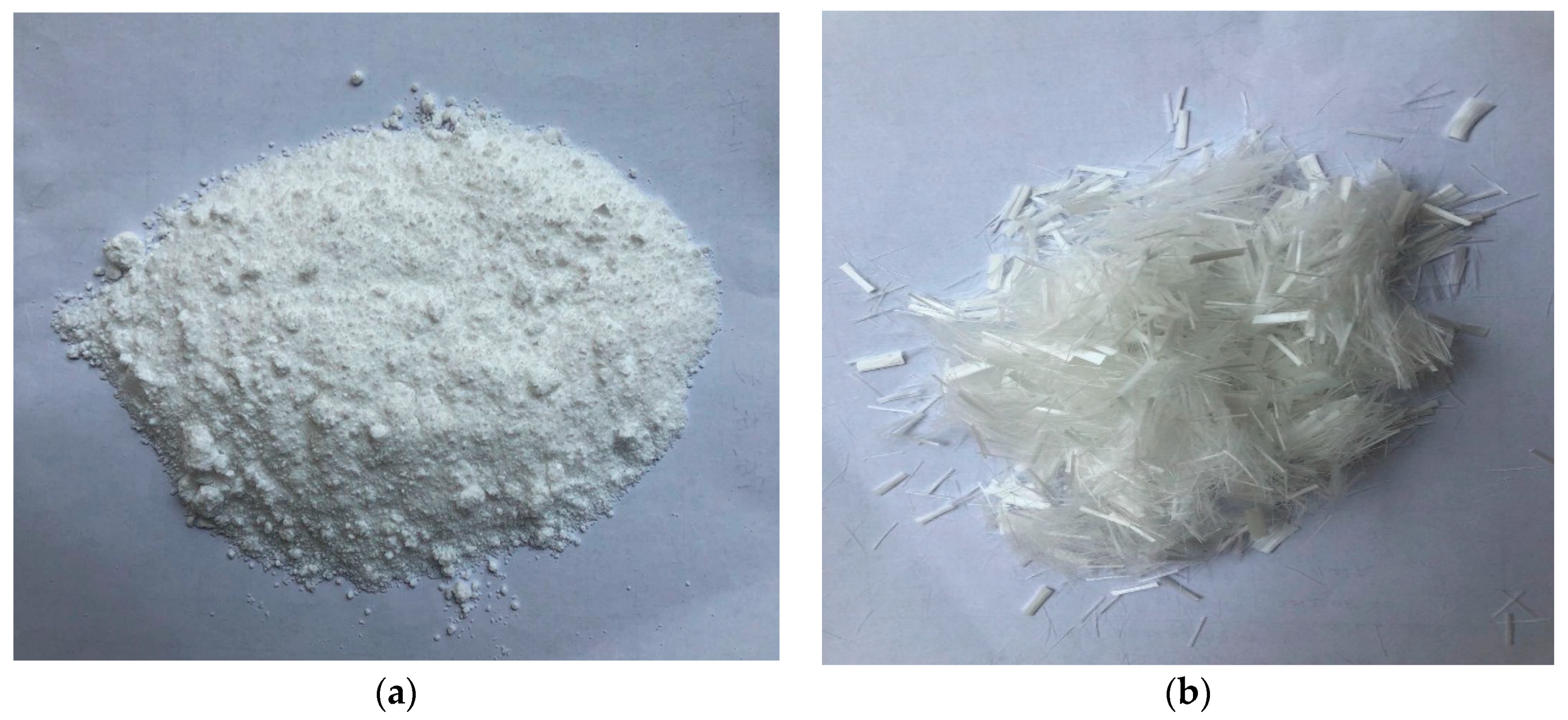


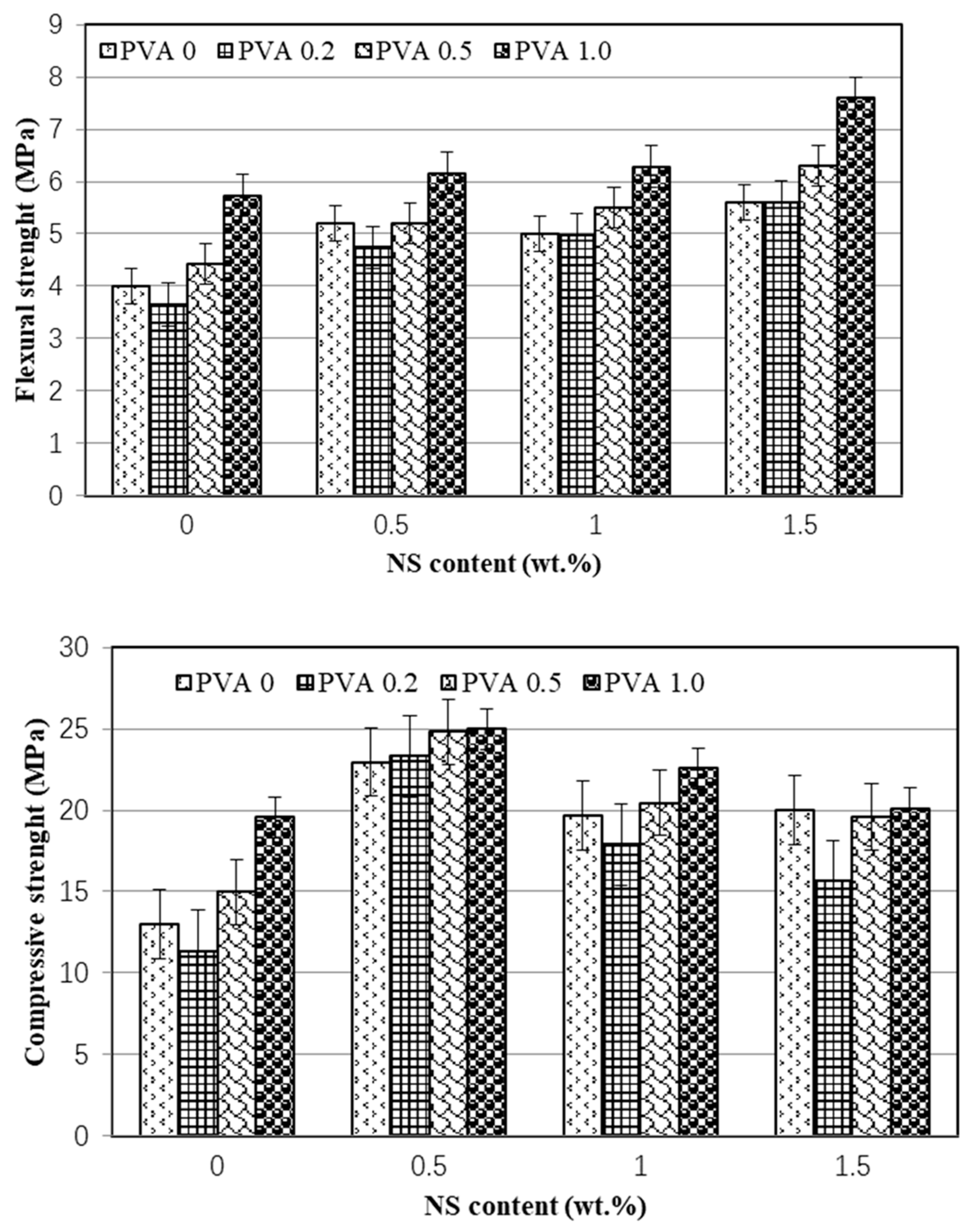

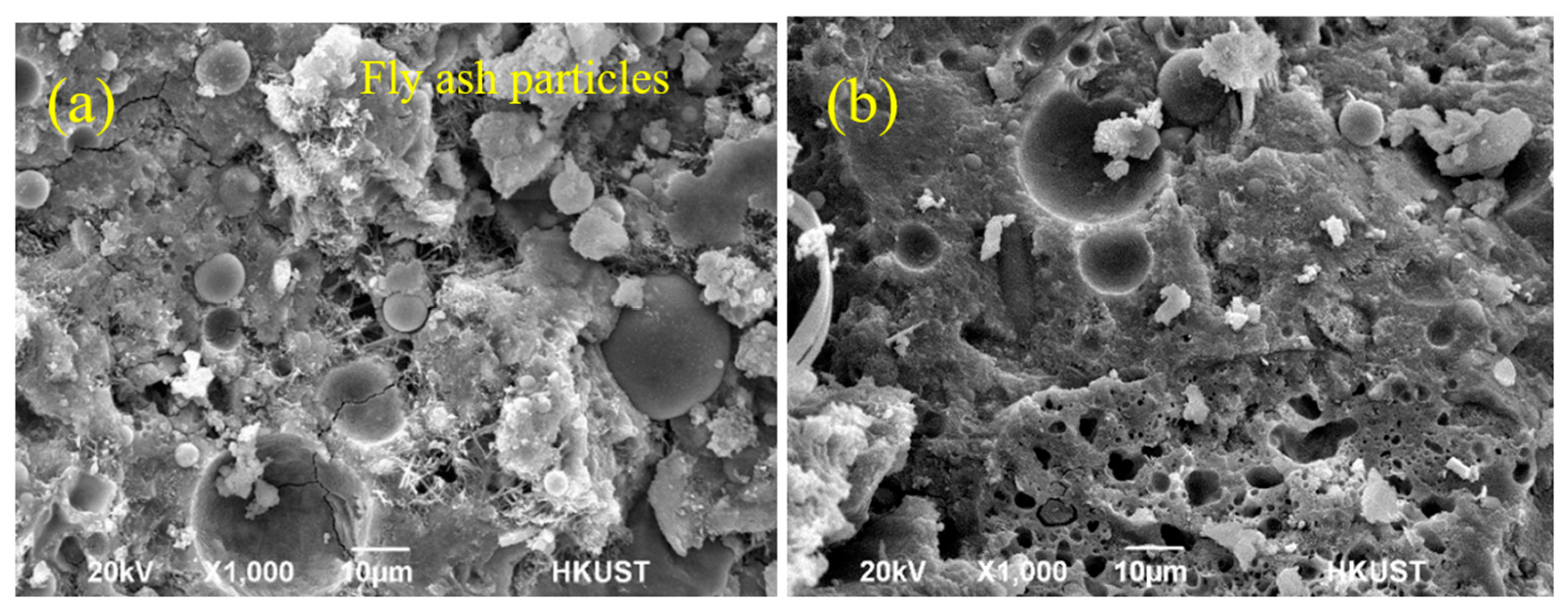
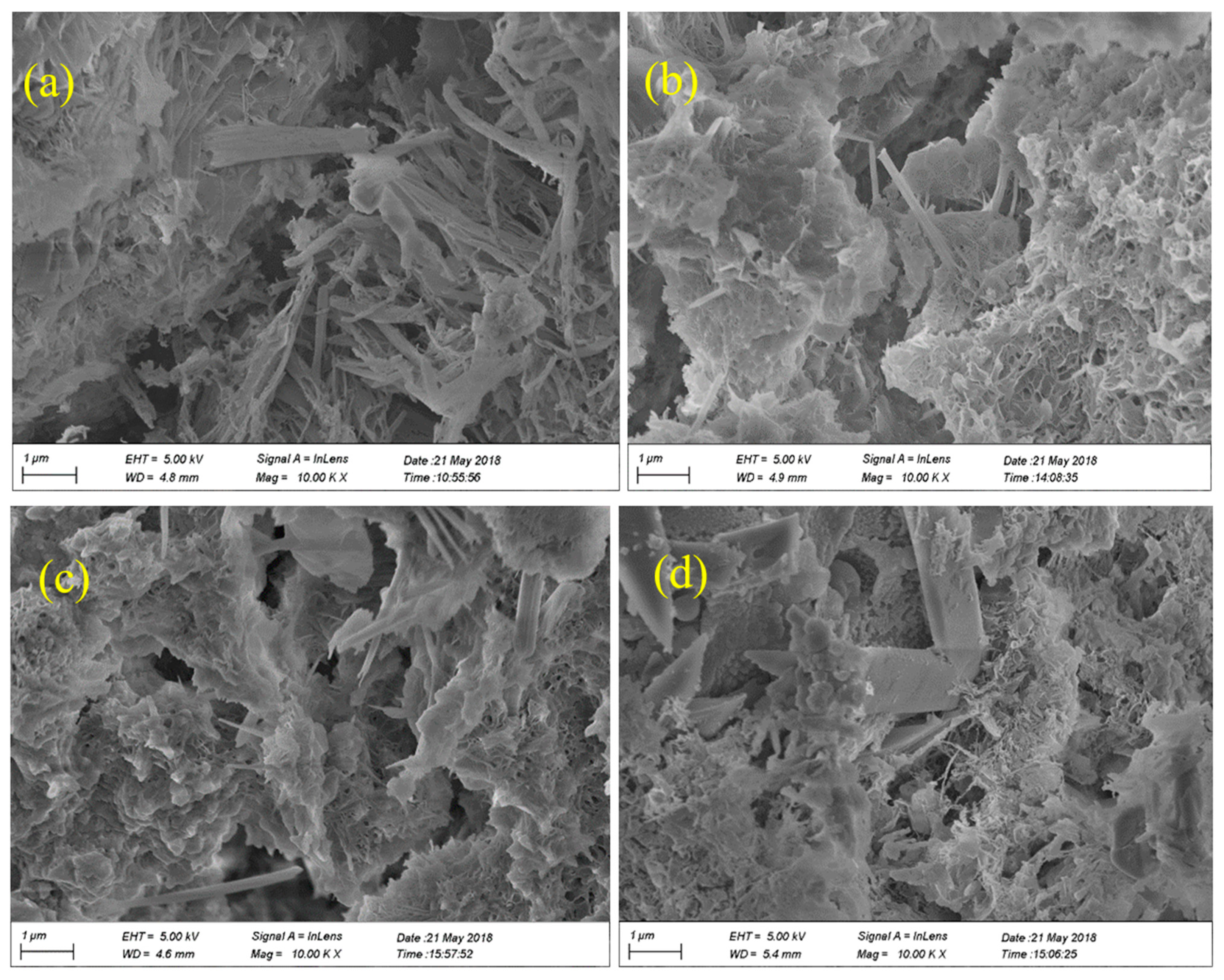


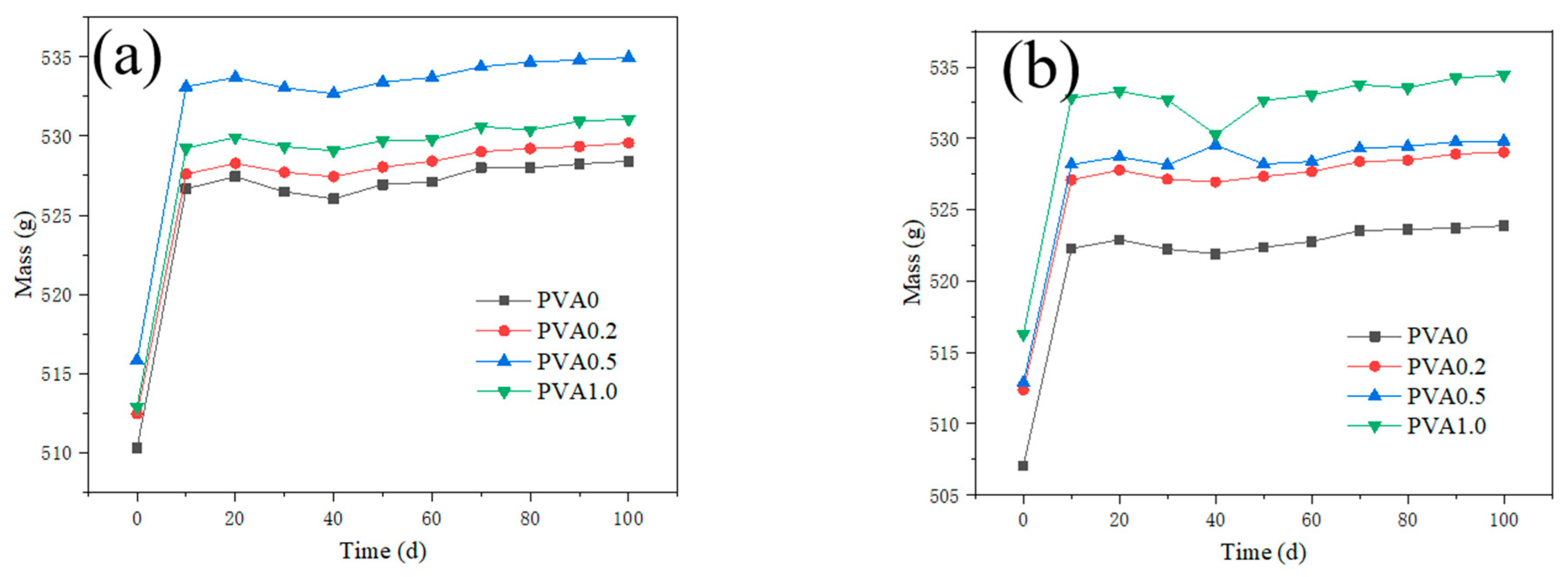

| SiO2 | Al2O3 | CaO | MgO | Fe2O3 | K2O | MnO | SO4 | LOI | Specific Surface, Blaine, m2 kg−1 | Compressive Strength, 28-Day, MPa | |
|---|---|---|---|---|---|---|---|---|---|---|---|
| Cement | 18.3 | 4.5 | 62.4 | 2.1 | 0.3 | 1.5 | 2.3 | 2.97 | 0.34 | 350 | 50.6 |
| Fly ash | 46.69 | 33.76 | 8.46 | - | 6.05 | 1.24 | - | 1.34 | 2.1 | 389 | - |
| SiO2 | 99.5 | - | - | - | - | - | - | - | - | 2133 | - |
| Diameter/mm | Length/mm | Density/g·cm−3 | Tensile Strength/MPa | Elastic Modulus/GPa | Elongation/% | Aspect Ratio |
|---|---|---|---|---|---|---|
| 0.038 | 12 | 1.3 | 1092 | 30 | 7 | 316 |
| Material | Mix Proportions | Nano-SiO2 (w)/% | PVA Fiber (vol)/% | Superplasticizer (w)/% | |||
|---|---|---|---|---|---|---|---|
| Water | Cement | Fly Ash | Sand | ||||
| NS0-PVA0 | 220 | 220 | 330 | 1100 | 0 | 0 | 1 |
| NS0-PVA0.2 | 220 | 220 | 330 | 1100 | 0 | 0.2 | 1 |
| NS0-PVA0.5 | 220 | 220 | 330 | 1100 | 0 | 0.5 | 1 |
| NS0-PVA1.0 | 220 | 220 | 330 | 1100 | 0 | 1 | 1 |
| NS0.5-PVA0 | 220 | 220 | 330 | 1100 | 0.5 | 0 | 1 |
| NS0.5-PVA0.2 | 220 | 220 | 330 | 1100 | 0.5 | 0.2 | 1 |
| NS0.5-PVA0.5 | 220 | 220 | 330 | 1100 | 0.5 | 0.5 | 1 |
| NS0.5-PVA1.0 | 220 | 220 | 330 | 1100 | 0.5 | 1 | 1 |
| NS01.0-PVA0 | 220 | 220 | 330 | 1100 | 1 | 0 | 1 |
| NS01.0-PVA0.2 | 220 | 220 | 330 | 1100 | 1 | 0.2 | 1 |
| NS01.0-PVA0.5 | 220 | 220 | 330 | 1100 | 1 | 0.5 | 1 |
| NS01.0-PVA1.0 | 220 | 220 | 330 | 1100 | 1 | 1 | 1 |
| NS01.5-PVA0 | 220 | 220 | 330 | 1100 | 1.5 | 0 | 1 |
| NS01.5-PVA0.2 | 220 | 220 | 330 | 1100 | 1.5 | 0.2 | 1 |
| NS01.5-PVA0.5 | 220 | 220 | 330 | 1100 | 1.5 | 0.5 | 1 |
| NS01.5-PVA1.0 | 220 | 220 | 330 | 1100 | 1.5 | 1 | 1 |
| Coad Number | 60% FA | |
|---|---|---|
| Flexural Strength (MPa) | Compressive Strength (Mpa) | |
| NS0-PVA0 | 4.00 | 13.00 |
| NS0-PVA0.2 | 3.65 | 11.35 |
| NS0-PVA0.5 | 4.43 | 14.98 |
| NS0-PVA1.0 | 5.73 | 19.56 |
| NS0.5-PVA0 | 5.21 | 22.95 |
| NS0.5-PVA0.2 | 4.74 | 23.33 |
| NS0.5-PVA0.5 | 5.21 | 24.81 |
| NS0.5-PVA1.0 | 6.16 | 25.00 |
| NS1.0-PVA0 | 5.00 | 19.68 |
| NS1.0-PVA0.2 | 4.98 | 17.90 |
| NS1.0-PVA0.5 | 5.50 | 20.46 |
| NS1.0-PVA1.0 | 6.28 | 22.58 |
| NS1.5-PVA0 | 5.59 | 20.00 |
| NS1.5-PVA0.2 | 5.60 | 15.63 |
| NS1.5-PVA0.5 | 6.30 | 19.59 |
| NS1.5-PVA1.0 | 7.59 | 20.10 |
Publisher’s Note: MDPI stays neutral with regard to jurisdictional claims in published maps and institutional affiliations. |
© 2022 by the authors. Licensee MDPI, Basel, Switzerland. This article is an open access article distributed under the terms and conditions of the Creative Commons Attribution (CC BY) license (https://creativecommons.org/licenses/by/4.0/).
Share and Cite
Huang, J.; Wang, Z.; Li, D.; Li, G. Effect of Nano-SiO2/PVA Fiber on Sulfate Resistance of Cement Mortar Containing High-Volume Fly Ash. Nanomaterials 2022, 12, 323. https://doi.org/10.3390/nano12030323
Huang J, Wang Z, Li D, Li G. Effect of Nano-SiO2/PVA Fiber on Sulfate Resistance of Cement Mortar Containing High-Volume Fly Ash. Nanomaterials. 2022; 12(3):323. https://doi.org/10.3390/nano12030323
Chicago/Turabian StyleHuang, Jingjing, Zhongkun Wang, Dongsheng Li, and Gengying Li. 2022. "Effect of Nano-SiO2/PVA Fiber on Sulfate Resistance of Cement Mortar Containing High-Volume Fly Ash" Nanomaterials 12, no. 3: 323. https://doi.org/10.3390/nano12030323






